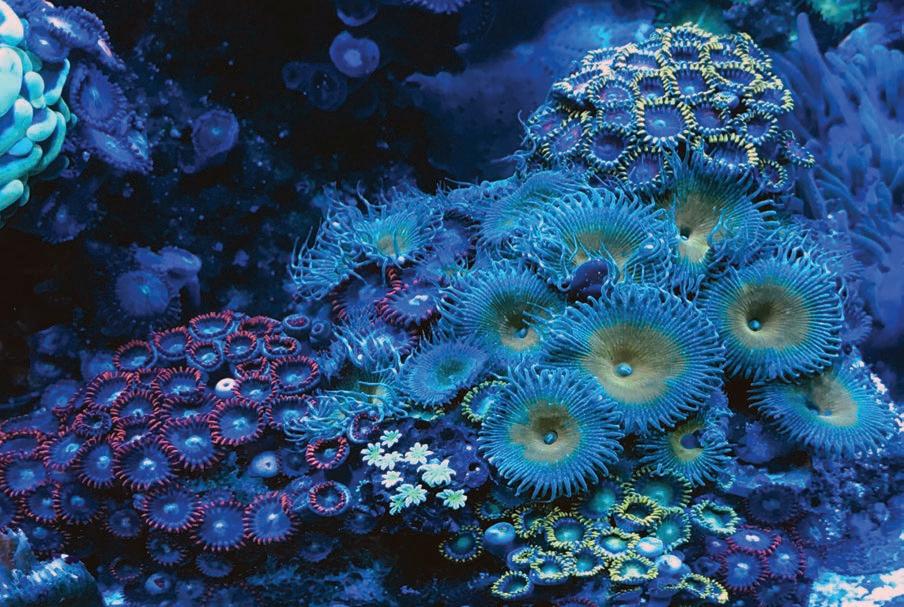
December 2022 volume XXIX number 10

ON THE COVER
Our cover photo this month is a rock cluster, in the center of which are Palythoa corals. The clusters on the left and right of center are Zoanthids. The photo is from Joseph F. Gurrado.
GREATER CITY AQUARIUM SOCIETY
Boa R D Me M B e R S
President Horst Gerber Vice-President Edward Vukich Treasurer Jules Birnbaum Assistant Treasurer Leonard Ramroop Corresponding Secretary Open President Emeritus Joseph Ferdenzi
Me M B e R S at La R G e Pete D’Orio Al Grusell Jason Kerner Dan Radebaugh Marsha Radebaugh
Co M M i ttee Chai R S Bowl Show Joseph F. Gurrado Breeder Award........................Harry Faustmann Early Arrivals Al Grusell Membership Marsha Radebaugh N.E.C. Delegate Artie Mayer Programs....................................................Open
Social Media Gilberto Soriano Technical Coordinator Jason Kerner
MODERN AQUARIUM
Editor in Chief Dan Radebaugh Copy Editors: Alexander A. Priest Susan Priest Donna Sosna Sica Thomas Warns
Advertising Manager Robert Kolsky
Series III Vol. XXIX, No. 10 December, 2022
In This Issue
From The Editor 2
G.C.A.S. 2022 Program Schedule 3 President’s Message 4 Our Generous Sponsors and Advertisers 5 Fishy Friendsʼ Photos 6
Tonight’s Speaker: Mark Soberman 7 Speaking on Corydoras Catfish November’s Caption Winner 7
Cartoon Caption Contest 8 by Denver Lettman
It’s All About the Base! 9 by Dan McKercher Pictures From Our Last Meeting 10 by Bill Amely My Life With Fish (6) 11 My First Dive by Jason Gold Tall Tales & Myths 13 Charybis by Dr. Glenn Roberts Wet Leaves 14 MA Classics The Ocean at Home by Susan Priest Orthochromis stormsi 15 A Rheophyllic Delight by Greg Steeves
Live Food For Tiny Fish 19 by Joseph Graffagnino G.C.A.S. Member Discounts 22 G.C.A.S. Classifieds 23 Modern Aquarium Covers 2009 24 MA Classics
The Undergravel Reporter 25 What In The Sea Is It? Fin Fun (Puzzle Page) 26 Back to the Future!
From the Editor
by Dan Radebaugh
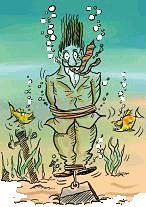
Well, here we are at the end of 2022. Covid hasn’t gone away, but the current strains of the virus don’t seem to be as deadly as those that typified the early pandemic. It’s still causing worldwide problems, but certainly not on the same scale as did the earlier versions of the virus. Those who have cloistered themselves at home certainly were not wrong to do so, as a review of the worldwide death statistics will verify, but nevertheless, we’re in a better place now than we were not so long ago.
Following our wonderful 100th Anniversary Gala in October, our November meeting was very well attended, and the auction and raffle contained a lot of excellent items. It’s also been great to once again have “live” speakers!
There’s an old saying that “the idle brain is the devil’s playground.” Well, mine has certainly not been overworked of late, so I’ve come up with a slightly revised approach to a couple of the things we’ve been doing in our magazine.
Last year we simplified the way we had been keeping up with our Breeders’ Award Program. This in turn has inspired me to look at our Author Award Program in Modern Aquarium. On the one hand, this program has provided us with a wonderful historical record of our club going back to 1994, when the current ‘Series III’ of Modern Aquarium was launched.
On the other hand, if there could be a criticism of the current model, I think it would be that it has been going on for so long that it has become more than a bit unwieldy, and difficult to maintain. There’s also the fact that newer members―even those like myself who have been here for a while, don’t remember or have never even heard of most of the names in that file. It’s great that we have all that historical information, but I think it’s time
to begin providing it in smaller bites. So my thought and intention is to print a yearly index. The current index through 2021 will still exist. It is stored online, so if we need to look up something we can still find it. We’ll continue to produce an index of the issues that we produce in each year. My intention with this change is to simplify our record keeping while still being able to find and read articles from all past issues.
Another change that I have in mind is to add an option for our members to show off some of their fish without having to write a full article. Instead, just send us a photo or two of your favorite fish (or plants or whatever) with very brief, bare-bones information, and we’ll create a page for these brief profiles in Modern Aquarium.
The contributing member wouldn’t have to do much in the way of writing, and we could combine several of these photos and profiles into a ‘Fishy Fotos’ (or whatever we decide to name it) page. These ‘lite’ profiles would still be eligible for author award points. Photos would be 5 points (10 points for two), plus 1 point for the accompanying bare-bones description. If any of you members out there are interested in doing something like this, send me a sample and let’s see what happens. You can email them to me at gcas@earthlink.net.

City A.S (NY) 2 December 2022
Modern Aquarium - Greater
GCAS Programs 2022
March 2
Scott Dowd Project Piaba April 6 Rosario LaCorte Images From A Lifetime of Fish Breeding
Articles submitted for consideration in Modern Aquarium (ISSN 2150-0940) must be received no later than the 10th day of the month prior to the month of publication. Please email submissions to gcas@earthlink.net, or fax to (347) 379-4984. Copyright 2022 by the Greater City Aquarium Society Inc., a not-for-profit New York State corporation. All rights reserved. Not-for-profit aquarium societies are hereby granted permission to reproduce articles and illustrations from this publication, unless the article indicates that the copyrights have been retained by the author, and provided reprints indicate source, and that two copies of the publication are sent to the Exchange Editor of this magazine (one copy if sent electronically). For online-only publications, copies may be sent via email to gcas@earthlink.net. Any other reproduction or commercial use of the material in this publication is prohibited without prior express written permission.
The Greater City Aquarium Society meets every month except January and February. Members receive notice of meetings in the mail or by email. For more information, contact: Dan Radebaugh at (718) 458-8437, email to gcas@earthlink.net, or fax to (347) 379-4984. For more information about our club or to see previous issues of Modern Aquarium, you can also go to our Internet Home Page at http://www.greatercity.net, http://www. greatercity.org, or http://www.greatercity.com.
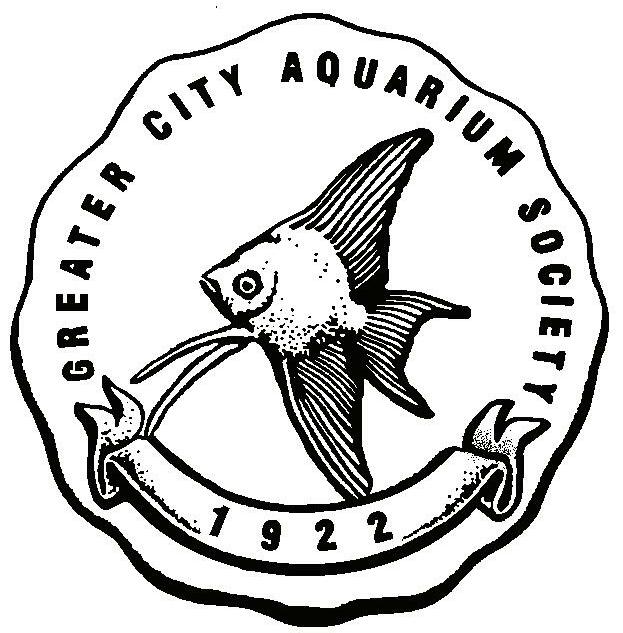
Modern
(NY) December 2022 3
Aquarium - Greater City A.S
June
August
September 7
October 7
November 2
December 5 (Monday)
May 4 Warren Feuer Shell Dwelling Cichlids
1 Dr. Enea Parimbelli Voyage in Lake Tanganyika July 6 Joseph F. Gurrado Reef Keeping
3 A Night at the Auction
Andreas Tanke Plecos of the Rio Xingu
Gala Buffet Dinner Douglaston Manor
Mark Denaro asia aquatics 2022
Mark Soberman Corydoras catfish
President’s Message
by Horst Gerber
As you read this, 2022 is almost over and done, and we are still alive and kicking. But what a year it has been! When this club started a century ago nobody knew about Covid 19 or the Omicron variant. My goodness! We are surviving, and now it looks like we have a handle on it.
When I took on the presidency I figured it would be for a year or two, never imagining anything longer, but here we are six years later, and I am being propelled into year seven. Don’t you think it’s about time for me to step down and let one of you younger members step up to the plate/podium?

Compared to some other clubs that I know of, Greater City is thriving, in spite of the difficulties posed by the pandemic. Jules, our treasured treasurer, has only good news about our finances. The Gala Banquet was a great success! We all had a wonderful time! The company was great, and the food and hors d’oeuvres were delicious!
With the holiday season upon us, the hobby will be a little bit on the back burner, what with all the shopping and decorating, delicious food, and visits to and from relatives. Some of us might even splurge on new tanks and/ or equipment to give us new uplift. It has of course been a tough time for all of us in the fish hobby, what with greatly reduced import of fish from abroad.
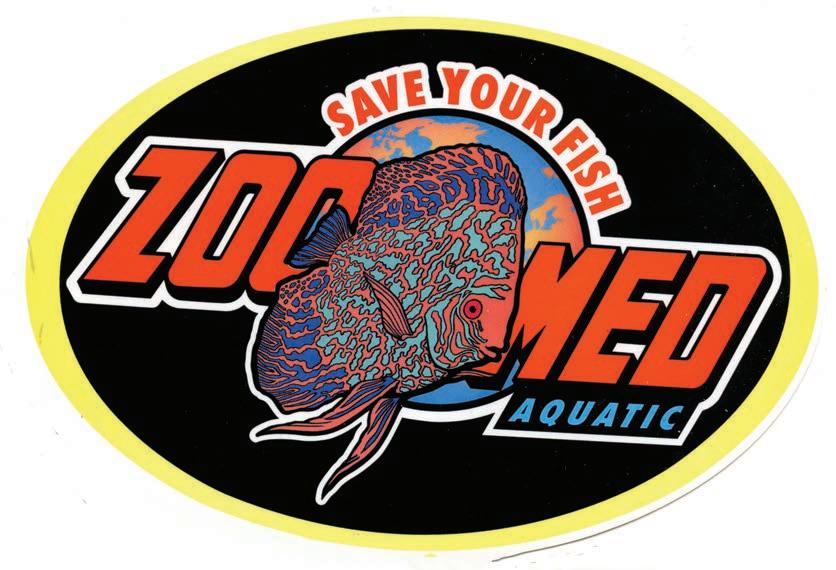
Recently, of all the places in the world, I ended up buying a gorgeous crown tail betta from a very limited pet shop in Cape Cod. I am going to put him in a bowl show and see how he does. I probably saved him from an early grave. The sales person knew nothing about fish, and thought that the little 10 ounce container you see so often in pet stores would be sufficient. I kept him in that container for the rest of that week’s vacation. Besides the bettas, the store had a couple of 20 gallon tanks with fish for sale. Very poor selection! They only had a small collection of platys and some small, feeder-size goldfish.
Happy Holidays to you all!
Horst
4 December 2022
Modern Aquarium - Greater City A.S
(NY)
Advanced Marine Aquatics
Al’s Aquatic Services, Inc.
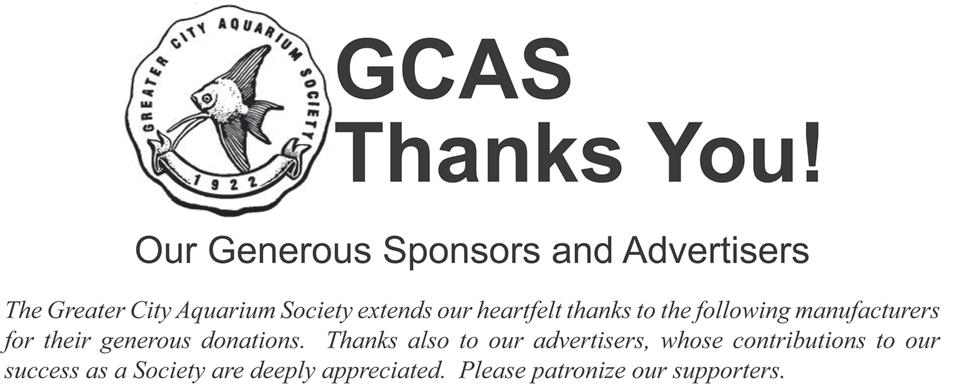
Amazonas Magazine
Aquarium Pharmaceuticals
Aquarium Technology Inc.
Aqueon
Brine Shrimp Direct
Carib Sea
Cobalt Aquatics
Coralife
Ecological Laboratories
Fishworld
Florida Aquatic Nurseries
Franklin Pet Center Inc
Fritz Aquatics
HBH Pet Products
High Quality Exotic Goldfish
Hydor USA
Jehmco
Jungle Bob Enterprises
Jungle Labs
Kent Marine
KHC Aquarium
Kissena Aquarium
Marineland
Microbe Lift
ModernAquarium.com
Monster Aquarium, Inc.
Nature’s Reef & Reptile
NorthFin Premium Fish Food Ocean Nutrition America
Oceanic
Omega Sea Pacific Aquarium, Inc.
Penn Plax
Pets Warehouse Pet Resources
Pisces Pro Red Sea
Rena
Rolf C. Hagen
San Francisco Bay Brand
Seachem
Sera
Spectrum Brands
Your Fish Stuff.com
Zilla
Zoo Med Laboratories Inc.
(NY) December 2022 5
Modern Aquarium - Greater City A.S
Fishy Friends’ Photos
by Greater City Aquarium Society Fishy Friends


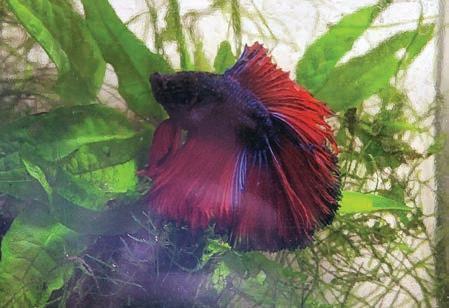
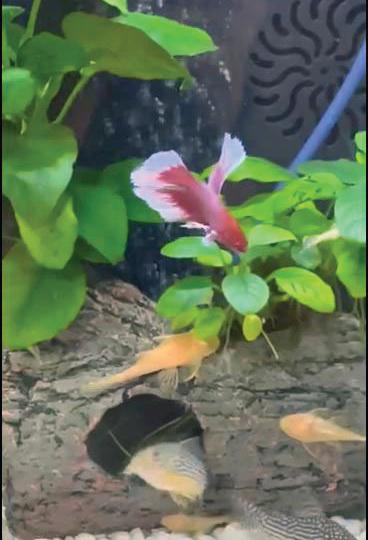

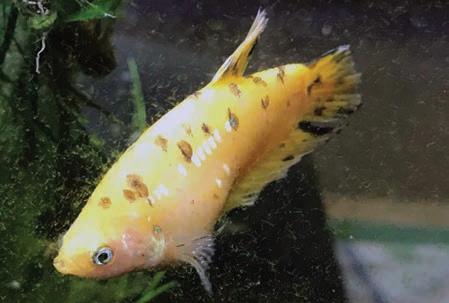
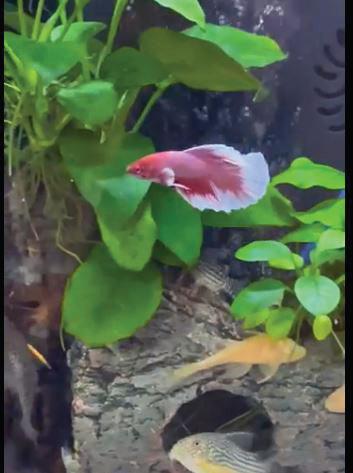
Below are photo submissions to our “Fishy Friends” Facebook group. I’ve left the subjects unnamed, but not the photographer. If you see a shot you like, and want more info, ask the photographer about it! I’m sure he or she will be delighted to tell you!
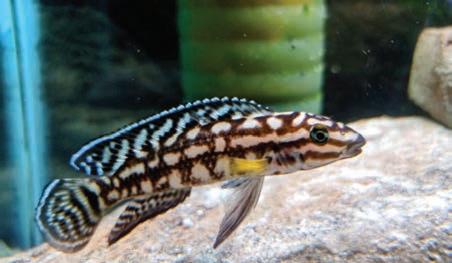
A.S (NY) 6 December 2022
Modern
Aquarium
- Greater City
Geri Domingo
Joseph Gurrado
Marsha Radedbaugh
Joseph Gurrado
Geri Domingo
Jim Cumming
Peter Goldfien
Tonight’s Speaker: December 5, 2022 Mark Soberman, on Corydoras Catfish

Mark has been keeping fish for over 44 years. He has been a member of the Greater City Aquarium Society since 1984, and has served on its board of directors for more than 20 years. Mark was enrolled in the Greater City’s Roll of Honor in 1998 and is one of the club’s top lifetime breeders.
Mark was involved with the formation of the North American Catfish Society as well as other catfish organizations. He has written articles for Tropical Fish Hobbyist, Modern Aquarium, Greater City’s award winning publication, in addition to other catfish journals. Mark was a moderator on www.PlanetCatfish.com and is now a retired “expert” on the site. He has traveled extensively, giving his programs across the country as well as to the Bermuda Fry-Angle Aquarium Society.
Although Mark specializes in breeding Corydoras and other catfish, over the years he has also bred cichlids, killies, characins and livebearers. Mark is currently involved in a variety of projects, and maintains 35 tanks. He is very interested in the history of the aquarium hobby and has an extensive collection of antiquarian aquarium literature and ephemera.
Mark was a panelist on the Corydoras Forum at the 2004 Potomac Valley Aquarium Society All Aquarium Catfish Convention and gave a program on African Catfish at the convention in October 2006, and an aquascaping program in 2008. In 2010 Mark gave the banquet program.
November՚s Caption Winner:

Amely
Modern
(NY) December 2022 7
Aquarium - Greater City A.S
Bill
So that's where I left my right shoe! Hope the fish in the fountain are ok!
The Modern Aquarium Cartoon Caption Contest

Modern Aquarium has featured cartoon contests before, and theyʼre back! You, the members of Greater City get to choose the caption! Just think of a good caption, then mail, email, or phone the Editor with your caption (phone:347-866-1107, fax: 877-299-0522, email: gcas@ earthlink.net. Your caption needs to reach the Editor by the third Wednesday of this month We'll also hand out copies of this page at the meeting, which you may turn in to Marsha or Dan before leaving. Winning captions will earn ten points in our Author Awards program, qualifying you for participation in our special ”Authors Only” raffle at our Holiday Party and Banquet. Put on your thinking caps!

8 December 2022
Modern Aquarium - Greater City A.S (NY)
Your Caption: Your Name: https://www.amazonasmagazine.com/
It’s All About The Base!
by Dan McKercher
About five years ago I got involved in a growout contest. For those of you who may not know what it is, in a grow-out contest the club chooses a fish and purchases a bunch of fry to hand out. The contest is for one year. In some cases cash prizes are given out for different reasons: Best of Show, Largest, etc… This was at the Pioneer Valley Aquarium Society, an all species club in the Springfield, Massachusetts area. Its members are a great bunch of folks.
It was decided that Corydoras sterbai would be the challenge of the year. Everyone who wanted to join in on the fun got two fish. I put mine in a 120 gallon tank and didn’t give it another thought. During that year my wife and I purchased a “new to us” house. In the moving all my fish were transferred into a 55 gallon tank in the dark basement of our new home until I could build my fishroom. A bit of a back story here. We moved from a log cabin with no basement to a ranch-style house with a full basement. Not to mention what my wife calls a “real furnace” with one of those fancy things on the wall that made the house get warmer/cooler just by turning a dial. Happy wife, happy life, right?

After I got the fishroom built I put my two new fish into a bare-bottom 10 gallon tank. They started to lay eggs! AND to this day they haven’t stopped! They would lay eggs and the eggs would do the fungus thing every time I pulled the eggs off the glass to place them in a separate container. So I moved them to a 2.5 gallon tank. The plan was for them lay eggs and I would move the parents to another tank. This would get a few eggs to hatch only to have them die off. Still bare-bottom tank.
I then changed my attack plan, adding methylene blue to the water after pulling the parents. Success! The numbers greatly increased. I did notice that only a few drops was not good enough. The darker blue I made the water the better the hatch rate I would get. You should know that I have made the water so dark that you could not see through the tank. It did not seem to inhibit the hatch rate.
So now I’m getting great hatch rates, BUT many were dying off. Did not matter how clean I kept the tank. I then added gravel from an established tank. Boom! They live! I have bred thousands of them in the past few years, and I still have the original pair still breeding. Talk about a cash cow! The gravel would come from any of my tanks as long as it is not crushed coral or shell.
About 3 months ago, I picked up a bag of pool filter sand. I got it home and noticed it was nothing
more than finely crushed glass. I thought nothing of it, and put some in a 2.5 gallon tank. Right away I noticed that the Corys stayed away from the bottom like the plague. I pulled the little fellas, then removed the sand and returned it for a bag of a different type of sand.
I did notice that the Corys did not really take to the white sand as well as to the seasoned gravel. You know one ought to take a hint if the apple snails will not venture on the bottom of the tank for a snack. So moving forward a month or so, I became unable to keep too many Corys. Even the fry didn’t want to be near the sand. With the seasoned gravel, the small fry would hang out under the base of the sponge filter. No longer. I would find them swimming in the water column or just above the bottom over the gravel until they died. After losing many fry I began to think that the pool filter sand is too abrasive for Corys. I went to Home Depot and picked up a bag of play sand. The little guys seemed to be happier with that, but not like the gravel that I would pull from a running tank.
One day I noticed a 20 pound bag of CaribSea Super Naturals Peace River Substrate sitting in the corner of the fish room. I had picked it up at a pet shop in trade for Corys. I sucked the sand out of the bottom of a 10 gallon tank that contained about 20 Corys. They have been in that tank now for about three months. They never hung out on the bottom, always swimming in the water table. It took not more than five minutes for them to land on the bottom of the tank on top of the CaribSea gravel looking really happy. I have since removed all the sand from all of my Cory tanks and everybody now seems to be a lot less stressed. Hopefully, this will stop the die-offs that I have been experiencing the past few months.
I did compare the three different gravels/sands. The pool filter sand seemed to be a very uniform product. The only thing I did notice was that it seemed to be very rough when rubbing some between my fingers. The Home Depot play sand wasn’t nearly as rough as the pool filter sand, but upon closely inspecting it I was able to find many different types of ground stone. This leads me to think that it may change the water chemistry. The Carib Sea was very uniform, and from the feel of rubbing it between my fingers it seemed to be the smoothest of the three. A classic case of you get what you pay for, I guess.
Moral of the story: When it comes to being thrifty, maybe the substrate isn’t the best choice to cut corners on when it comes to bottom dwellers.
Modern Aquarium - Greater City A.S (NY) December 2022 9
Pictures From Our Last Meeting

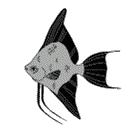

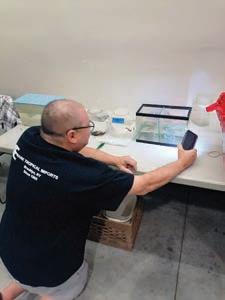
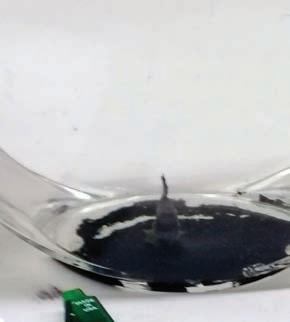
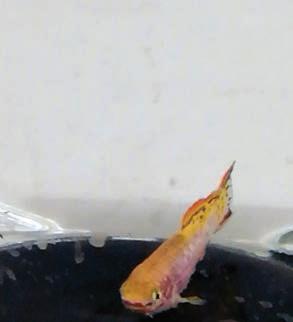
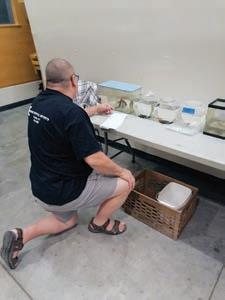
10 December 2022
Modern Aquarium - Greater City A.S (NY)
Photos by Bill Amely
1. Pete D'Orio -- Angelfish
Our Speaker Mark Denaro doubled as Bowl Show Judge! 2. John Buzzetti -- F. amieti 3. John Buzzetti -- F. gardneri (gold)
My Life With Fish (6) My
First Dive
by Jason Gold
When I was 21 and about to graduate college, I met my future wife. Or, as it turned out, my future ex-wife. We’d actually met a few times before that—she was a high school friend of one of my best college friends and used to visit campus from time to time. But when she came to her friend’s (and my) graduation, we really hit it off. We started dating a few weeks later and moved in together a year after that, just as I was getting ready to start architecture school in NYC.
Her family was fairly affluent, and always went to Barbados over the winter holidays. She’d been going for years, since she was a child, and now that we were living together, I was invited too. I’d had incurable wanderlust since I was a kid hanging on every exploit of the fish and plant explorers in my hobby books and magazines. I love to go to just about anywhere. In fact, I just love to go, period. Motion in itself is intoxicating to me. And I came by it naturally—my mom also loves to travel; my dad and sisters not so much. So yeah, Barbados sounded great, and the day after my classes ended we jetted off. It was gorgeous! We stayed at this little motel right on the beach on the western, calmer side of the island. And I, loving all things watery, was in heaven. I was also young and in love, and what could be better than that?
The beach was public. There were lots of local hawkers selling handicrafts and ice pops and t-shirts and offering to take you sailing or water skiing. But mostly I’d just take my snorkel, mask, and fins and go searching for sea life, although in the surf close to shore there wasn’t all that much to see—a few clusters of coral boulders attended by urchins and a few small, bright fish, fighting against the ebb and flow of the surf just like me. Plus, I never really loved snorkeling—all that gasping and spitting and wrestling with the choppy surface. And if there was something that warranted a closer look, I’d first take a big breath and then, my lungs full of buoyant air, found it nearly impossible to get more than a few feet below the surface. Frustrating. But it was water-y and fish-y, so I kept at it.
After a few years of being part of this annual trip with my girlfriend’s family, a guy on the beach offered something new―scuba lessons. Scuba…with all my years in the aquarium hobby, how had I never
really considered that? I was a freshwater hobbyist, but even so…. I signed up. No one else in our group was interested—not my girlfriend nor her younger brother nor any of the friends we’d made where we were staying—so I went myself.
We met the following morning at another motel a short way down the same stretch of beach. There were maybe eight of us. Our instructor showed us how to use the clunky equipment as the rest of us exchanged doubtful glances that any of this would actually work. Then we all got into the shallow end of the pool to try it out. With my mask on in front, my tank on in back, and my BCD, weights, and fins on below, and of course the regulator clenched in my mouth, it was time to take my first breath underwater. I hesitated, thinking of all that coughing and sputtering that came with my attempts at snorkeling. “C’mon man, it’s just like breathing regular,“ the instructor encouraged. I tentatively put my face into the water, waited a couple of seconds, and inhaled. All air! No water! Just like the guy said― just like breathing regular! Nice!
Having gotten over the hurdle of doubting that that jumble of nylon and plastic and metal, all those tubes and straps and buckles would actually allow us to breathe underwater, we had about an hour’s instruction in the deep end of the pool on how to enter the water and be neutrally buoyant to control our position underwater. And then he declared us ready to head out to the sea. OK…if you say so.
Barbados is not known as a primo scuba destination. The island is separate from the main Caribbean archipelago, sixty-odd miles east in the open Atlantic. And it’s neither a shallow sandbar nor a volcano like many of the islands of the Lesser Antilles, which marks where the South American tectonic plate dips beneath the Caribbean Plate, causing the subducted seabed to melt and the resulting magma to rise volcanically to the surface. Instead, it’s a chunk of old seabed and coral limestone and geological junk that’s been scraped off the subducting plate and uplifted by the main tectonic action to its west. In geological terms, it’s an accretionary wedge. It’s surrounded by deep waters, and although there are reefs, they’re difficult to dive. But within that ancient
Modern Aquarium - Greater City A.S (NY) December 2022 11
uplifted limestone is a treasure that made the place irresistible to the native Caribs and European colonists alike―caverns full of fresh water, filtered through the limestone. And the combination of colonial (and contemporary) trade and ocean-scoured coral meant shipwrecks in the shallower waters close to shore, which became the anchorages for sea life and a draw for scuba divers.
Since we weren’t fully certified divers—“resort divers” is the term they used—we couldn’t go deeper than a breath’s distance from the surface, about 40 feet. We piled onto a dive boat and headed out. At a seemingly random spot in the ocean we stopped. This was it, huh? I guess they knew what they were doing. We climbed awkwardly into the heavy equipment, inflated our BCD’s, put one hand over the mask and regulator and the other across the gauges and tubes, and performed the giant stride water entries we’d practiced at the pool. I was now bobbing in the Atlantic. So far so good!
We got the signal to descend. I let a bit of air out of my vest and started to sink. The water was warm and clear. This breathing underwater thing was going OK. Then I looked down. I couldn’t see the bottom―just an infinity of deepening blue. My heart started to race with fear, as though there were no bottom at all and I would just keep sinking and sinking forever. I cleared my ears and tried to get ahold of my gut reaction, the impulse to flee to the surface. We sank through schools of little silver fish, which helped calm me down. I thought of the schooling fish in my aquarium back home: “Hey, tiny little guys like this wouldn’t be hanging out where there was no place nearby to hide, right?” Soon the bridge of a wrecked freight barge came into view below, then the large rectangular form of the vessel itself, dark against the sandy bottom. Once I saw that, I was fine. There was a bottom, a finity in all this vastness. Barracuda were cruising above this wreck, zipping like missiles though our shoal of divers. As we got closer to the sunken barge, sponges and corals and all those beautiful fish like the ones I knew from the saltwater section of the aquarium stores I frequented were busy—very busy— plying their living on this makeshift reef.
Diving opened a miraculous world for me. Even a giant public aquarium cannot provide more than a fraction of the experience of being immersed in the immensity and majesty and power of the ocean and seeing these tiny creatures in their zillions, teeming on reefs and wrecks, patrolling their territories, defending their tiny burrows and crannies or their spot in the perpetual current, living out their complex relationships whether in a narrow crevice or the vast, open blue of this amazing planet. And the awkwardness and heft of the equipment, the fumes and noise of the boat engine, the chop of the waves, all vanish underwater, yielding to weightlessness and three-dimensional mobility and utter silence but for my own Darth Vader-ish breathing,
indescribable sensations and emotions, a loneliness and a oneness that only amplify the visual wonders.
We got the signal to head back up to the surface. I arrived at the boat grinning and exhilarated and ready for more and more and more. The guy helping me out of the equipment checked my gauges. “Were you holding your breath, man?” he asked, “you still have half a tank of air.” “No, I was breathing, but I was just so…so…calm.”
I did three dives that trip. It took a bit of fiddling for me to get the hang of actually being neutrally buoyant in the water, swimming without my hands, going where I wanted to go, and staying put when I wanted to get a closer look at something. But I got there—or close enough.

A couple of years and maybe five or six resort dives later, we’d all outgrown the family trips. No longer on academic schedules, both ensconced in the working world, we now had to deal with realities like paid vacation time and living within our own means and planning a wedding. Besides, my fiancé and I really didn’t want to spend all our vacation time with our parents and siblings any more. I still had the wanderlust that had been inspired by a childhood of reading in TFH about fish collecting in faraway places. Once we had young children, and then as our loving marriage dissolved into something entirely different, the adventurous travel would have to go on hold. It would be years before I had the opportunity or ability to dive or travel again.
But wanderlust isn’t just a desire, it’s a demand. My love of this planet, its people and places, its crush of life, the wonders of the sky and the sea and the mountains and the plains lived on in me and poured itself into the aquarium in my home and my community garden in Riverside Park and the wide, wide world of New York City’s vibrant and diverse neighborhoods. Taking the 7 train to Woodside or Flushing or the B to Brighton Beach was as immersive to me as a trip to Bangkok or Shanghai or Odessa, despite the cognitive dissonance of MTA buses barreling down the streets.
The Union Square Greenmarket was a place of abundance, vibrant and affirming. And aquarium stores like Pacific and Monster, especially fish that were in their wild forms not altered by selective breeding, the occasional imports like Heckel discus and Altum angels and even the more common things that still come from the wild like Clown and Kuhli loaches, all of these could still transport me in an empathic flash to their native haunts in Java or Peru. NYC is amazing that way, the whole world at our fingertips with the swipe of a MetroCard. Aquariums are amazing that way too. Give me a fish in a bowl and that will be my RV, my steamship, my jetliner, my magic carpet!
Drawing from Shutterstock.
(NY) 12 December 2022
Modern Aquarium - Greater City A.S
Tall Tales & Myths
Charybdis

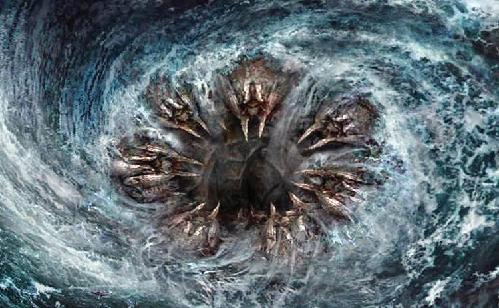
 By Dr. Glen Roberts
By Dr. Glen Roberts
Leave it to the Greeks to have yet another sea monster myth. This monster, called Charybdis, was said to live beneath a small rock on the coast of the toe of Italy. Directly across from it, on the coast of Sicily was its counterpart, Syclla. Syclla was a much larger monster. The passageway between the two was treacherous. The trick was to find a way between Charybdis and Scylla while not getting wrecked. Charybdis was thought to gulp in huge amounts of water once a day, only to belch it out later, causing a huge whirlpool. Of course, there is a very “rational” reason Charybdis did this. Charybdis was the daughter of Poseidon. Her uncle was Zeus. Zeus got angry because Charybdis helped her father to steal land from him. In retaliation, Zeus captured Charybdis, chained her to the seafloor, and turned her into a huge bladder monster who had an uncontrollable thirst for sea water. See, I told you it was rational!!
As it turns out, there is in fact a whirlpool in the strait between Italy and Sicily, but that’s all it is. Just a whirlpool that is only dangerous to very small boats and could never swallow a ship. The only place I’ve seen a whirlpool is in my bathtub, but I’ll still watch out just in case Charybdis is lurking down there!
Modern Aquarium - Greater City A.S (NY) December 2022 13
monstervault.com
Society’s Fins & Tales , Volume 58 Issue 3March, 2019.
Reprinted
from The
Kitchener-Waterloo
Aquarium
a Series On Books For The Hobbyist
by SUSAN PRIEST
This book has had the effect of reeling me in over and over again. If it wasn’t the title of a chapter, it was an illustration that made me ask myself, “what is that?” or merely yearn to learn more about it (for examples, the pelican eel or the symbiotic relationship between a hermit crab and a sea anemone). Then there were the color paintings which were interspersed throughout. I kept sinking into those with no desire to float back to the surface.
The introduction is called “Dive In.” The author opens his book with the following quote (in part): “The first-time visitor to an aquarium cannot contain his inner excitement. His curiosity is so great that he can hardly enjoy the moment.”
More familiar to present-day historians of the hobby will be the contributions of such authors as Philip Henry Gosse and Hugo Mulertt. Not only did they help to transport the hobby from marine to freshwater, but they also helped to bring it “across the pond” to America.
Chapter Three, entitled “Pet Fish,” fills our imaginations with such images as this: “Several centuries before the birth of Christ, the people of Lykia, a region in southwest modern-day Turkey, played flutes to lure “Holy Fish” to the surface in order to question them about the future,” or this: “Pliny the Elder wrote of people who kept oracular fish whose acceptance or rejection of food translated to a good or ill omen.” It would seem fair to say that as long as people and fish have cohabited the earth, we have exhibited a fascination with them.
The Ocean at Home An Illustrated History of the Aquarium Bernd Brunner Princeton Architectural Press, 2005
In 1860 Gustav Jager built the first public saltwater aquarium in Vienna, and this is what he observed in the faces of its visitors.

Let me reel you in as well by teasing you with a few of the chapter titles: “Passion and Diligence,” “A Strong Intensive Desire,” “Exotic Species and Transport,” “Fashion Show,” “The Aquarium as a Dream.”
The first people whose curiosity drew them to the ocean and its secrets quickly learned that they couldn’t bring themselves under the water, so they had to bring the water –and its occupants – out to them. The earliest forays into aquariums almost exclusively dealt with ocean life.
Most of the focus of this book is the second half of the 19th century. The majority of the earliest non-fiction literature on the subject was written by European authors, and mostly in German or French. Fictional works by such authors as Victor Hugo and Jules Verne were also penned at this time.
Of particular interest to readers of Modern Aquarium is the chapter on “Aquarist Societies and Magazines.” The tightly woven tapestry of people and publications cannot be encapsulated here. I rarely recommend to my readers in so many words that they acquire a book under my review. In this case I must suggest that anyone with a keen interest in these topics seek out a copy for the detail available in this chapter alone.
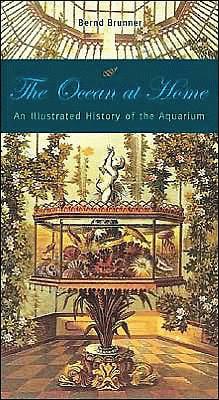
Mr. Brunner repeatedly returns to the theme that aquariums first and foremost belong to the realm of science, but that they are forever being taken one step further in a variety of different directions such as art, entertainment, or oneupmanship (out-doing your neighbor). Where is your aquarium taking you?
This book was originally published in German in 2003, and was translated into English for this edition. Some translations leave you tripping and stumbling, but this translation was done so smoothly and seamlessly that readers will not find any cracks in its literary pavement. Simply put, this book is a joy to the eye, and a pleasure to read.
14 December 2022 18 September 2008
Modern Aquarium - Greater City A.S (NY)
Modern Aquarium - Greater City A.S. (NY)
MA Classics
This article first appeared in the September 2008 issue of Modern Aquarium
Orthochromis stormsi
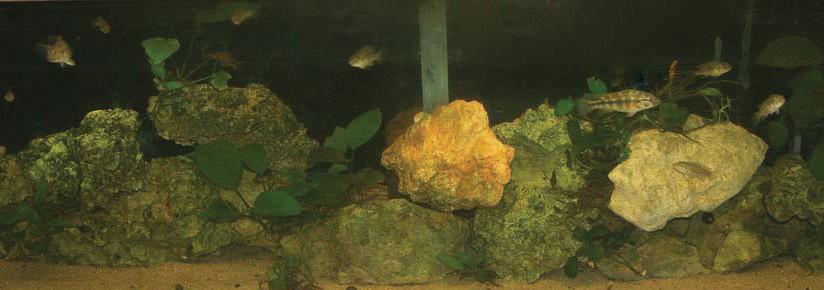
a Rheophilic Delight
By Greg Steeves
What great fortune it was sitting at the American Cichlid Association auction in Clear Lake, Texas this summer. Among the beautiful fish being offered were several bags containing Orthochromis stormsi. Before I had left home, I had told myself, “Self, you have no room for any new fish,” but as with pretty much every auction I’ve ever attended, there is something that passes I simply have to have. When the first bag of O. stormsi came up, I bit my lip, sat on my hands, and let the trio of fish go. Instant regret washed over me. I couldn’t help thinking that the person winning the bid was some jabroni that had no idea of the incredible little cichlid he had just purchased. I had the pleasure of maintaining O. stormsi several years ago, but hadn’t seen them since. I really enjoyed this fish, and while sitting, lamenting over the group gone by, a second trio came up for auction. It was time. I won the bid and then another trio afterwards. I had a group of six fish that looked to be two young males and four females. A perfect ratio! I passed the time on the four-hour ride home thinking about how to arrange things to house these cichlids.
The fish I snagged were far from adult. That said, I have had haplochromines spawn very small before and I wouldn’t be at all surprised if these were almost there. Due to their rheophilic nature, it is fairly easy in terms of occupation of the water column, to house these with other haplochromines. The thing to watch with
them is aggression. I knew from experience that them by themselves in a species-only configuration was not the best method. I had learned a hard lesson on this the last time I had the privilege of setting up an aquarium for them. As fate would have it, I had moved a group of young Thoracochromis sp. “flavententis” to a 55 gallon tank to raise as my next breeding population. I thought that the Orthochromis stormsi would work perfectly with them. I forewent the quarantine process and transferred the fish directly from the bags they had been in since the auction, to the aquarium. You would think after being in the hobby as long as I have, I would know better, but in they went. In this circumstance, fate was on my side and the two species have made terrific tankmates so far. Knowing both fish and their temperaments, I was sure they would get along fine. So far so good.
Although the genus Orthochromis was established by P. H. Greenwood in 1954, of the 14 named species and several others undescribed, O. stormsi has been the only one I have seen available, until very recently, to U.S. hobbyists. Orthochromis machadoi may have been sporadically available, but I have never seen it. As of late, a handful of other Orthochromis species are available. I’m certain that these will be highly sought after amongst cichlid hobbyists, as they stay relatively small, have a varied temperament, and are quite colorful. O. stormsi is not a fish that stands out based on appearance, as its subtle
cichlid.org, or contact Claudia Dickinson, ACA Membership Coordinator, PO Box 5078, Montauk, NY 11954, or ivyr ose@optonline.net.”
Reprinted from Buntbarsche Bulletin , official publication of the American Cichlid Association, Inc (ACA). To join the ACA, visit the website,

Modern Aquarium - Greater City A.S (NY) December 2022 15
coloration is likely not a large attraction to the novice. To those of us interested in behavior however, all the Orthochromis species are likely to elicit enthusiasm.
All Orthochromines are rheophilic species. This means that due to a reduced swim bladder, they generally stay along the bottom or perched on objects slightly raised above the substrate. Known species occur in the Congo River system and several small river systems around Lake Tanganyika. It is thought that most, if not all the species in this genus are herbivores, due to their long intestinal tract. Fish with exaggerated digestive tracts are generally vegetableeating or detritus-sifting species. Food is retained longer, passing through more enzymes to aid in processing plant food than omnivores and carnivores. This is a generalization, and even though it is accurate for most species, there are always exceptions. This said, a diet high in plant matter is recommended.
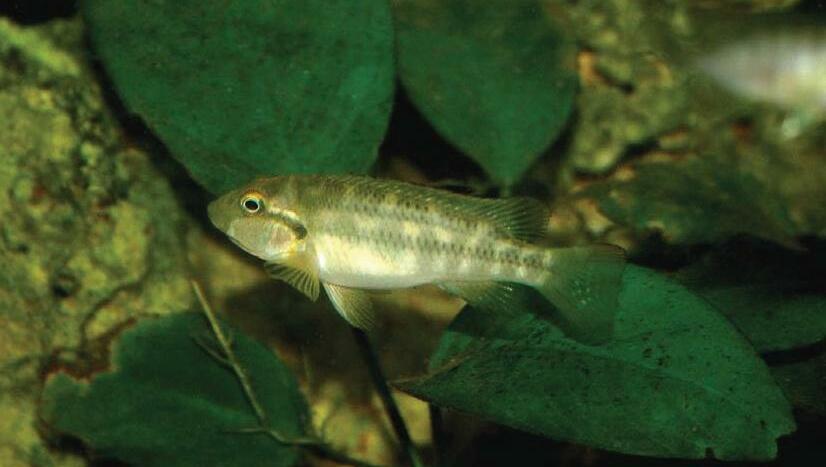
I have the aquarium housing Thoracochromis sp. “flavententis” and Orthochromis stormsi in a manner that I am hopeful I will not have to change. I have rockwork stacked towards the back of their aquarium with Anubias nana clumps spread throughout. As this group is maturing, an obvious dominant male is emerging. The rocks and plants aid in breaking up the line of sight from overly aggressive fish. I employ this technique in many of my aquaria. As of now, the fish have not nibbled or harmed the A. nana. This is a hardy plant that I incorporate into my décor in most of my cichlid tanks. It also helps to give holding females places to brood their fry. Substrate is smooth pool filter sand. I wanted to avoid larger, silicatype substrate. The fish will be spending a lot of their time along the bottom of the aquarium, so it’s a good idea not to involve anything with sharp edges here. The majority of my tanks contain airdriven sponge filtration. This one is no exception. I have a small
submersible pump concealed behind some rocks. This is part of my semi-automatic water changing system allowing me to perform frequent water changes with minimal effort. I’m all about that!
Going back through old notes of my previous run with Orthochromis stormsi, I had jotted down a couple of points of interest. The fish do not have ocelli (egg spots) on their anal fins. Pretty much all other haplochromine cichlids do, with the possible exception of Pseudocrenilabrus species. The other was that male mouthbrooding had been observed in the genus. I can’t recall where this information had come from, but I did witness male mouthbrooding occur in the Lake Victoria species Neochromis greenwoodi, so this is certainly not out of the question.
Orthochromis stormsi is described from the Lindi River in Zaire. Locations where it can be found include the Upper Congo (Lualaba) River and tributaries, and in Lake Mweru in the Lower Congo River. It mostly inhabits slow-flowing shallows near the shore. A temperature of 24-28°C seems ideal. Our water had a pH of around 8, and O. stormsi appears to flourish in these conditions. Again, a diet geared towards herbivores is recommended.
There are no pastel colors on these cichlids. The overall coloration is tan brown on lighter flanks with a black cross-hatched barring pattern running the length of the body. The male’s head is a gray, almost blue color and both sexes have a beautiful red outline to the eye. A strong black bar begins below the corner of the mouth and runs to the opercular spot. This creates a beautiful face mask. The fins are clear with a yellow tinge.
With the onset of maturity, spawning activity is sure to follow. The male may or may not excavate a pit in the substrate, but as is typical with haplochromines, will shimmy to the female in between bouts of chasing
Modern
- Greater City A.S (NY) 16 December 2022
Aquarium
off any other fish. When the female becomes ripe with eggs, she will submit to the male’s constant advances and engage in a process of circling the male. She will drop eggs and quickly turn to pick them up in her mouth. The male releases milt and fertilization occurs. Once spent, the female will retreat to a quiet area to brood her clutch. She can often be seen “chewing,” which is the process of turning the eggs in her buccal cavity. After 18-22 days, the fry will have absorbed their yolk sac and are allowed to forage near the mother. At the first sign of a possible threat, the female will scoop the fry back into her mouth for safety. This can continue for 2-3 weeks, after which time the fry are left to survive on their own. An average clutch in my experience has been around 15 eggs.
Behaviorally, Orthochromis stormsi is such a fun fish to watch. I equate them to the hummingbirds of the fish world. That is, they seem intolerant of

each other but rarely is any harm inflicted other than being chased away and left with a bruised ego (do fish have an ego?). Males will often sit perched on a rock carefully watching the area around them. They sometimes remind me more of mudskippers than haplochromine cichlids.
What great fortune it was to find these amazing fish once again. I find myself drawn to their aquarium, watching their interactions with each other and with their tankmates. I do hope a spawn is forthcoming because I would like to spread fry so that others could enjoy these fantastic fish. As I close this article, I can’t help but wonder how O. stormsi compares to other Orthochromis species. Maybe, if I play my cards right, someday I’ll get the chance to find out!

Modern
- Greater City A.S (NY) December 2022 17
Aquarium


Modern Aquarium - Greater City A.S (NY) 18 December 2022 If you like history, and you like pets, then this is the
for you. Dedicated to the
of
& pet keeping, The
of
& Pet History includes a huge depository of over 3,000 items all focused on the pet industry. From antique fish bowls, aquariums and cages, to foods, medications, books and advertising signs, we’ve got it all! To learn more about this
collection of
pet artifacts, please visit our
place
history
aquarium
Museum
Aquarium
amazing
historical
website: moaph.org https://moaph.org/
Joe Graffagnino - BAS
Joseph Graffagnino
I have been raising and breed ing trop ica l fish for over 40 y ears. Man y times I a m aske d ab out wha t typ e of fo ods a re ide al fo r re ally tiny fish. I he ar that some use crushed flakes, others cut up live or frozen worms and ot h e rs a d d b r i n e s h r i m p , e ith er a dult or bab y b r i n e l i ve o r f ro z e n . M a n y assume th at even if the ba by fish ca n’t ingest the food , the y w i l l e a t a r o u n d i t a n d o b t a i n nutrition that way. This may wo rk
if the fry are o ld er and la rger an d ca n take bites fro m foo d too la rge for them to take in the ir mo uths.

LIVE FOOD FOR
TINY FISH
There are exceptions to this such a s catfish th at will ra m their bod y over an egg to get it in the ir mouth an d wait a d ay or so for the egg to b rea k down and en te r the ir stomach. For the most pa rt, if the b aby fish can’t get the food in its mouth, i t w i l l ignore it to the po in t whe re it will sta rve to d ea th.
Modern Aquarium - Greater City A.S (NY) December 2022 19
4
Reprinted from Aquatica –NovemberDecember 2018; Brooklyn Aquarium Society.
The best food for tropical fish is live food. This is especially true for tiny fry fish such as wild bettas, gouramis, certain catfish, tetras, barbs and others in the minuscule size. These fish fry look like ½ of a human eyelash. Tiny fish are very susceptible to water depth, temperature, pH, hardness, light, and too many other variables to mention. Any of these factors could cause the fry’s demise. They need a healthy and safe environment to survive. As a hobbyist, you want the fry to grow as quickly as possible. The larger it becomes, the better the chance it can handle stress and survive to an adult size where it can complete the cycle and reproduce more fry.
I have created a list of live foods from the tiniest to the largest to provide a choice for you to feed to your baby fish that will provide them the correct food to allow them to grow and prosper. Some of these may overlap in size but there are differences in the shape of the animal that would make it easier for fish to swallow. I will provide what I think is the smallest to the largest live foods.

Infusoria is a singlecelled organism consisting mainly of ciliate protozoans. There are an estimated 2,000 – 3,000 types of infusorians
protozoa. Infusoria are created from decaying vegetable matter. Be careful with the use of infusoria because, if left in a small glass container for longer than a day or so, it will start to decay and emit a foul smell. Replace it with a fresh supply immediately before feeding to your fry. The size of infusoria is 25 um [micrometer] – 300 um. By definition, a um = 1/1,000 of a mm [millimeter].
you should see the paramecium swimming in the water. The paramecium will be clear and look like a tiny cloud of wavy lines. Take a pipette or small siphon tube to squirt it into the tiny fry tank. The paramecium will survive for several days in the aquarium. The size of a paramecium is 50 um – 300 um (0.0020 – 0.0130 inch).
2 3 4 5 6
Paramecium – is a form of infusoria, an easy to raise live animal created by using a banana skin, plain tap water, and a starter culture to activate this solution. Always use a glass container, not plastic. A 2 or 3-liter containerwill last 34 months. Remove the live paramecium from the container via a turkey baster into a smaller glass container (a 12-ounce Corona beer bottle is perfect for this because it is clear and has a long neck). Add the paramecium solution to the bottle until it is halfway up the neck of the bottle. Place a piece of filter floss halfway down the neck of the bottle to the top of the paramecium solution. Add aquarium water to fill the rest of the neck of the bottle. The paramecium will travel up the solution, travel through filter floss to ascend into the aquariumwater. Hold the bottle up to the light and
Rotifers are another type of freshwater zooplankton. There are 2,200 species of rotifers. Rotifers eat algae. The size of a rotifer is 50 um – 0.1 –0.5 mm long.
Banana worms measures 50 microns in diameter and 2 millimeters in length. These worms can live for 24 hours. They are ½ the size of a micro worm
. Walter worms are very similar to banana worms and are minimally larger than banana worms. These worms can live for 24 hours.
Vinegar eels are made the same way as paramecium, except instead of a banana, use an apple cut into 6 pieces. The size of a vinegar eel is 2 millimeter
Modern
City A.S (NY) 20 December 2022
Aquarium - Greater
5
1


Modern Aquarium - Greater City A.S (NY) December 2022 21
So Long, Joe!


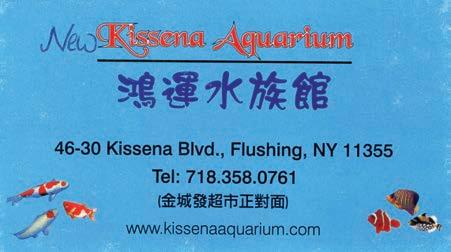
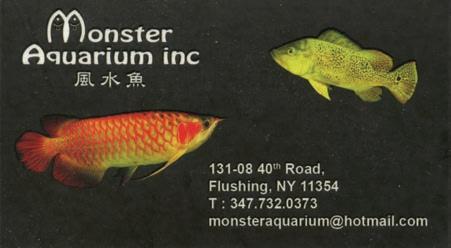




Modern Aquarium - Greater City A.S (NY) 22 December 2022 10% Discount on everything except ʽon saleʼ items. 20% Discount on fish. 15% on all else. 10% Discount on everything. 10% Discount on everything. 10% Discount on everything. 10% Discount on fish. 10% Discount on everything. GCAS Member Discounts at Local Fish Shops 10% Discount on everything.



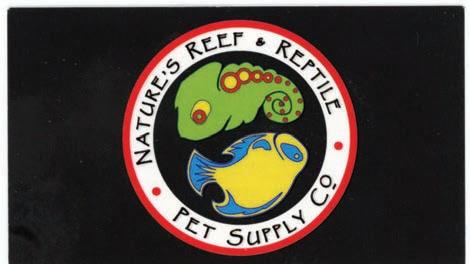




Modern Aquarium - Greater City A.S (NY) December 2022 23 10% Discount on everything. 10% Discount on everything. 15% Discount on everything in store, or online at: http://www.junglebobaquatics.com Use coupon code gcas15. 10% Discount on everything. FOR SALE: High Koi Angelfish, I have around 25 quarter size offspring. ANTHONY SIANO 917-855-2234 // asiano9090@aol.com GCAS Classifieds
Modern Aquarium Covers 2009

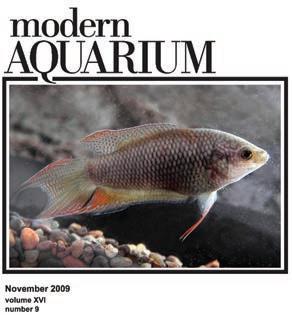

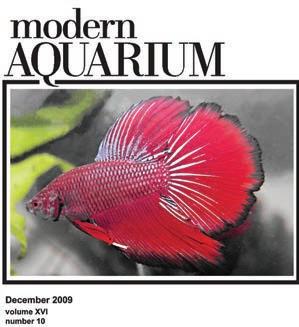


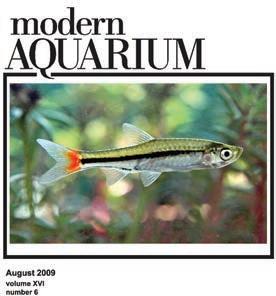
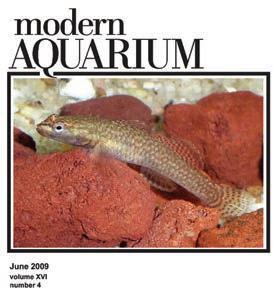

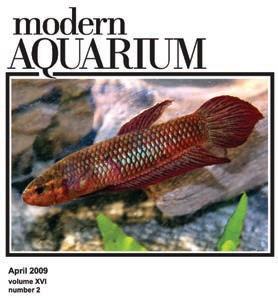
March 2009 Ferdenzus giuseppi by Claudia Dickinson
April 2009 Betta coccina by Alexander A. Priest
May 2009 Nematobrycon lacortei by Marsha Radebaugh June 2009 Rhinogobius duospilus by Michael Vulis
July 2009 Betta pulchra by Alexander A. Priest August 2009 Paretroplus menarambo by Alexander A. Priest September 2009 Neolamprologus similis by Alexandra Horton October 2009 Poecilia velifera by Alexander A. Priest November 2009 Macropodus erythropterus by Alexander A. Priest December 2009 Betta splendens by Alexander A. Priest

Modern
- Greater City A.S (NY) 24 December 2022
Aquarium
A series by the Undergravel Reporter

An Australian fisherman recently left social media users baffled by his unlikely catch of a mysterious deep-sea shark with protruding teeth and large eyes. Taking to Facebook, Trapman Bermagui, a Sydney-based fisherman, posted a photo of the face of the deep sea shark caught at a depth of 650 meters underwater.
Speaking to Newsweek via Facebook, Bermagui had this explanation: “It's a rough skin shark, also known as a species of endeavor dog shark. These sharks are common in depths greater than 600 meters. We catch them in the wintertime usually.”
The bizarre creature has a distinctive appearance with rough-looking skin, a pointed nose, large eyes and a protruding set of sharp teeth. “The face of a deep sea rough skin shark. All the way from 650m,” Mr. Bermagui captioned the post.
References:
Dean Grubbs, associate director of research at the Florida State University Coastal and Marine Laboratory, also weighed in. He told Newsweek the species appears to be Centroscymnus owstoni , also called the roughskin dogfish. “In my deep-sea research, we have caught quite a few of them in the Gulf of Mexico and in the Bahamas. Ours have come from depths of 740 to 1160 meters (~2,400 to 3,800 feet), so a bit deeper than this report. They are in the family Somniosidae, the Sleeper Sharks, the same family of the Greenland Shark, but obviously a much smaller species.”
https://www.ndtv.com/offbeat/viral-photo-deep-sea-shark-with-bulging-eyes-and-biza rre-teeth-caught-by-fisherman-in-australia-3348977

https://www.newsweek.com/deep-sea-shark-caught-australia-dogfish-1742987

Modern Aquarium - Greater City A.S (NY)
Modern Aquarium - Greater City A.S. (NY)
25
December 2022
December
17
2022
Fin Fun

One hundred years! The final FinFun puzzle for this centennial year surrounds our Society’s logo (actually one of several we’ve had over the years, but always featuring our signature fish—the freshwater angelfish, Pterophyllum scalare).




Modern
- Greater City A.S (NY) 26 December 2022
Aquarium
Birnbaum Faustmann Ferdenzi Gerber Grusell Gurrado Kerner Kolsky Mayer Priest Radebaugh Ramroop Soriano Vukich Warns 24 December 2022 Modern Aquarium - Greater City A.S. (NY)
Solution to our last puzzle:


100th Anniversary! 1922-2022





























 By Dr. Glen Roberts
By Dr. Glen Roberts













































